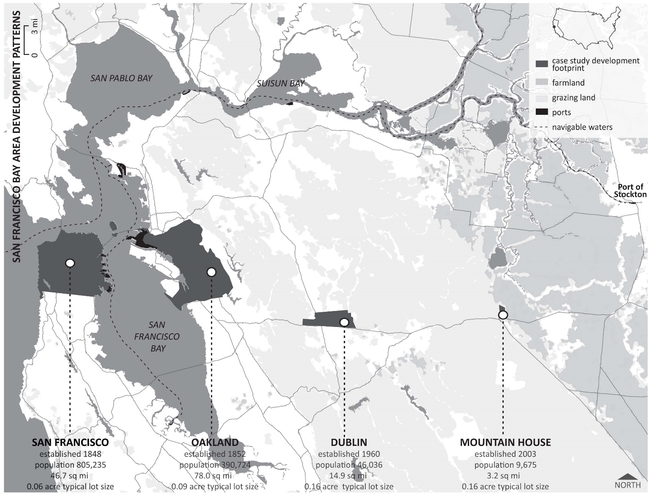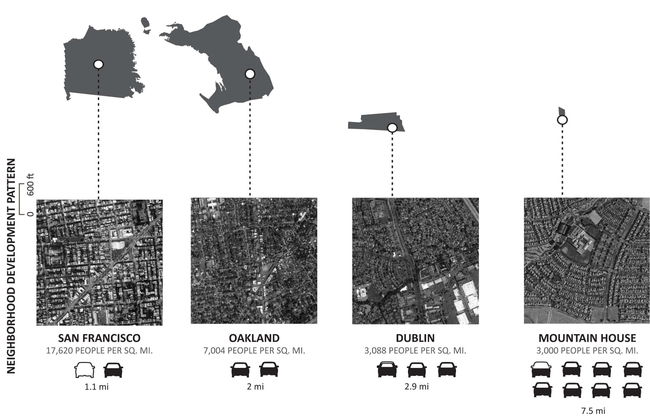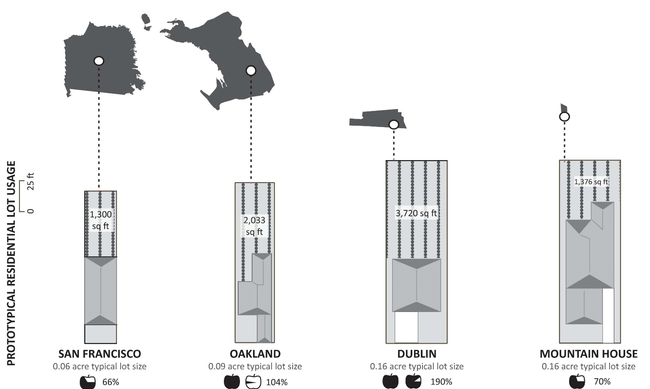Evaluating Regional Food Resilience in the San Francisco Bay Area
While the provision of clean water, removal of wastes, and infrastructure for other basic human necessities are considered in the planning of modern development in the United States, the provision of food is rarely a consideration. More often, transportation infrastructure, including roads, ports, and rails, is considered synonymous with food infrastructure, and little attention is paid to distances from the development to food retail, distribution hubs, ports, or food sources. In modern development it is assumed where there is a road, there will be food. This was not the case in pre-Industrial development; limited means of high-speed transportation, and the absence of technologies such as refrigeration, required carefully planned development to maximize efficiencies of transportation and proximities of food sources.As communities strive for increasingly sustainable means of development, an important consideration is planning for food resilience, of the ability to secure food within one's community in light of outside stressors such as natural disasters or limited fuel resources. Food resiliency requires balancing several considerations related to the locality of food, and contains a greater degree of complexity than the popularized 100 mile ‘local food' radius. While greater densities of development receiving efficient modes of food distribution offer one facet of food resilience, lower densities that offer opportunities for in-situ production provide yet another.
This research investigates relative food system resiliency by evaluating opportunities for adapting food systems within existing community patterns. The San Francisco Bay Area provides a relevant case study of both pre- and post-industrial development at a range of densities and networked with multiple transportation infrastructures. The evaluation of communities within this region reveals important considerations for environmental designers aiming to increase food system resilience in new and existing communities. This includes examining multiple scales of adaptation to production and distribution networks, and challenges the popularized 100 mile ‘local food' radius for achieving regional food resilience.
The study examines a convenience sample of four communities on a rough east-west transect within the San Francisco Bay Area and along Interstate 580: San Francisco, Oakland, Dublin and Mountain House. See Figure 1. The communities represent a range of densities, area coverage, and populations which correspond roughly to their location along the transect, with the larger and denser communities (San Francisco and Oakland) at the western end, and the smaller and less-dense communities at the eastern end of the transect. The transect is important in both geographic and historical terms, as the western end also corresponds to the oldest community with development occurring in an east-ward expansion.
At the scale of the neighborhood, the study identified travel distance to a full-service retail grocery store as the most significant criterion for assessing community food resilience. Using aerial photography and GIS data, a maximum one-way travel distance within each community to a full-service retail grocery store was established. For this study, a full-service retail grocery store was defined as a supermarket carrying fresh produce, such as Safeway, Andronico's or Lucky's. Convenience stores which sell primarily soft drinks, alcoholic beverages and snacks, were not included, as they do not typically provide access to fruits and vegetables (or other whole foods). The study calculated the average distance to a full-service retail grocery store within the community.
The study also defined the ‘productive potential' of each community, a measure of a typical back yard's ability to meet the fruit and vegetable diet for a family of four, based on average home lot size and coverage, USDA consumption figures and typical home-garden yields. A combination of aerial photographs, zoning maps and real-estate data for each community was analyzed to determine a typical lot configuration for each community, illustrating the average lot size, average home size and coverage. Although individuals may choose to use open space areas on their lots in a variety of ways, including ornamental landscaping, xeriscaping, recreational features such as basketball courts, lawn and hardscaping, in addition to food gardening, the productive potential of any lot is pre-determined by open space provided. Raised bed gardening, a typical home-garden approach to growing food, yields an average 1.24 pounds per square foot. In the U.S. an average of 1.5 pounds of fruits and vegetables is consumed per person per day. The productive potential of each community was derived from applying the raised bed average yield to 90% of the typical lot open space in each community, and then calculating what percentage of the full-year fruit and vegetable diet for a family of four would be met by that yield.
Flexibility is key to resilience. While San Francisco might not be able to produce all its fruit and vegetable needs via urban agriculture, access to multiple neighborhood grocery stores and to efficient modes of food distribution offer alternative means of adopting alternative food systems. Oakland, shares many of the same advantages as San Francisco, but with greater lots sizes (and generally a better microclimate), opportunities for urban agriculture are far greater. Dublin, while not sharing the same access to efficient modes of food distribution as San Francisco and Oakland, offers the greatest opportunities for residential urban agriculture with a productive potential of 190%. With minimal opportunities for home production, great distances between home and local grocery retail, and removed location from efficient distribution centers, the community of Mountain House appears to be the least capable of adaptations to the existing food system.
The results of this research exemplify the need for environmental designers to balance considerations of density and geographic location in new development. While density provides opportunities for limiting personal automobile commute times, it can also interfere with opportunities to promote UA as an alternative food source. Recognizing the geographic location of new development, the impacts to food distribution networks, and the proximity of local food retail outlets should also be an important consideration for environmental designers. In essence, the infrastructure of a community's food system (including global, regional, and local sources and distribution networks) should be an equal consideration to new development in the San Francisco Bay Area, and beyond, if community's are to be designed as resilient food systems.


